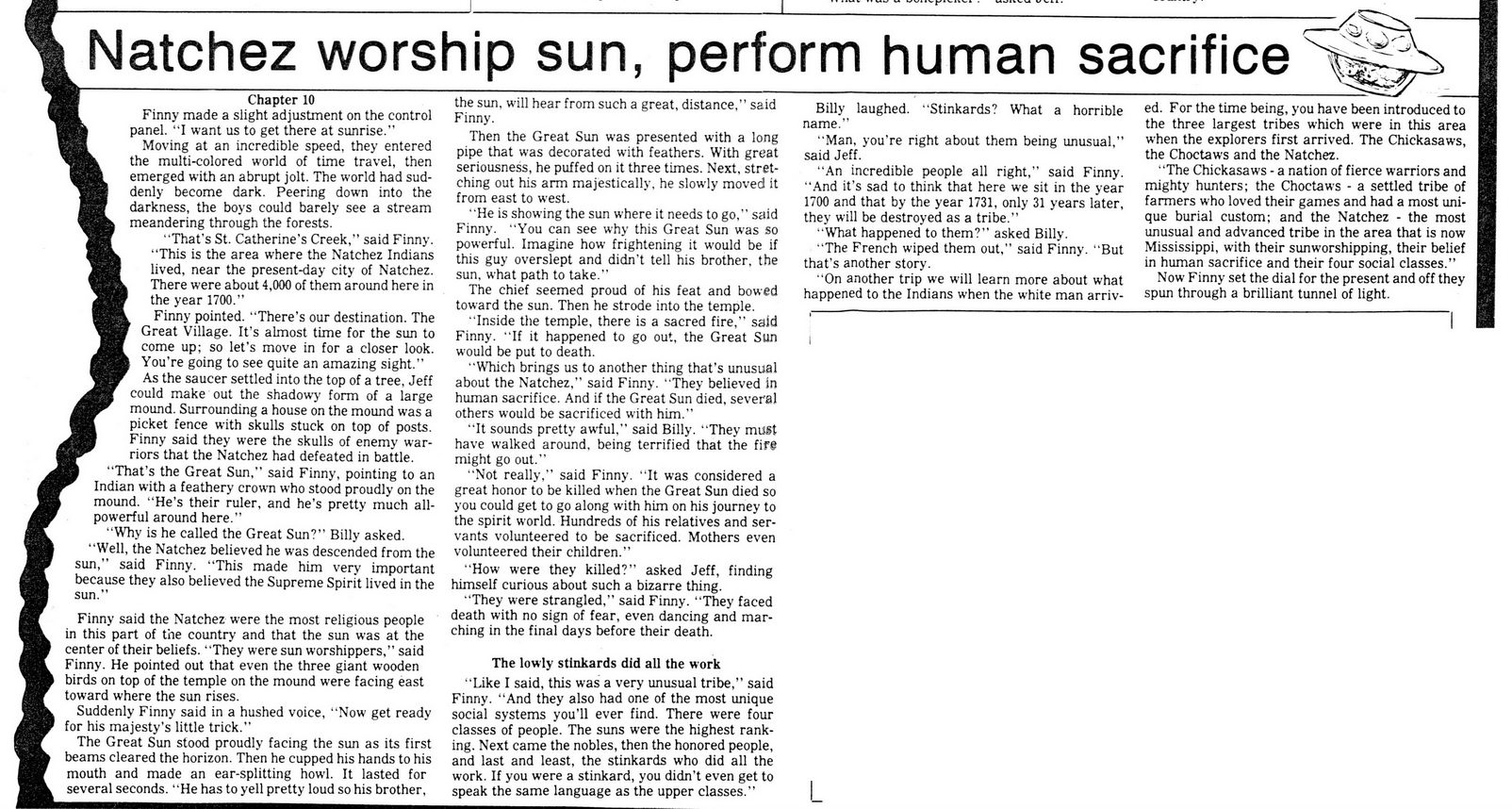This text was obtained via automated optical character recognition.
It has not been edited and may therefore contain several errors.
Natchez worship sun, perform human sacrifice Chapter 10 Finny made a slight adjustment on the control panel. “I want us to get there at sunrise.” Moving at an incredible speed, they entered the multi-colored world of time travel, then emerged with an abrupt jolt. The world had suddenly become dark. Peering down into the darkness, the boys could barely see a stream meandering through the forests. “That's St. Catherine’s Creek,” said Finny. “This is the area where the Natchez Indians lived, near the present-day city of Natchez. There were about 4,000 of them around here in the year 1700.” Finny pointed. “There’s our destination. The Great Village. It’s almost time for the sun to come up; so let's move in for a closer look. You’re going to see quite an amazing sight.” As the saucer settled into the top of a tree, Jeff could make out the shadowy form of a large mound. Surrounding a house on the mound was a picket fence with skulls stuck on top of posts. Finny said they were the skulls of enemy warriors that the Natchez had defeated in battle. “That’s the Great Sun,” said Finny, pointing to an Indian with a feathery crown who stood proudly on the mound. “He’s their ruler, and he’s pretty much all-powerful around here.” “Why is he called the Great Sun?” Billy asked. “Well, the Natchez believed he was descended from the sun,” said Finny. “This made him very important because they also believed the Supreme Spirit lived in the sun.” Finny said the Natchez were the most religious people in this part of the country and that the sun was at the center of their beliefs. “They were sun worshippers,” said Finny. He pointed out that even the three giant wooden birds on top of the temple on the mound were facing east toward where the sun rises. Suddenly Finny said in a hushed voice, “Now get ready for his majesty’s little trick.” The Great Sun stood proudly facing the sun as its first beams cleared the horizon. Then he cupped his hands to his mouth and made an ear-splitting howl. It lasted for several seconds. “He has to yell pretty loud so his brother, the sun, will hear from such a great, distance,” said Finny. Then the Great Sun was presented with a long pipe that was decorated with feathers. With great seriousness, he puffed on it three times. Next, stretching out his arm majestically, he slowly moved it from east to west. “He is showing the sun where it needs to go,” said Finny. “You can see why this Great Sun was so powerful. Imagine how frightening it would be if this guy overslept and didn’t tell his brother, the sun, what path to take.” The chief seemed proud of his feat and bowed toward the sun. Then he strode into the temple. “Inside the temple, there is a sacred fire,” said Finny. “If it happened to go out, the Great Sun would be put to death. “Which brings us to another thing that’s unusual about the Natchez,” said Finny. “They believed in human sacrifice. And if the Great Sun died, several others would be sacrificed with him.” “It sounds pretty awful," said Billy. “They must have walked around, being terrified that the fir® might go out.” “Not really,” said Finny. “It was considered a great honor to be killed when the Great Sun died so you could get to go along with him on his journey to the spirit world. Hundreds of his relatives and servants volunteered to be sacrificed. Mothers even volunteered their children.” “How were they killed?” asked Jeff, finding himself curious about such a bizarre thing. “They were strangled,” said Finny. “They faced death with no sign of fear, even dancing and marching in the final days before their death. The lowly stinkards did all the work “Like I said, this was a very unusual tribe,” said Finny. “And they also had one of the most unique social systems you’ll ever find. There were four classes of people. The suns were the highest ranking. Next came the nobles, then the honored people, and last and least, the stinkards who did all the work. If you were a stinkard, you didn’t even get to speak the same language as the upper classes.” Billy laughed. “Stinkards? What a horrible name.” "Man, you’re right about them being unusual,” said Jeff. “An incredible people all right,” said Finny. “And it’s sad to think that here we sit in the year 1700 and that by the year 1731, only 31 years later, they will be destroyed as a tribe.” “What happened to them?” asked Billy. “The French wiped them out,” said Finny. “But that’s another story. "On another trip we will learn more about what happened to the Indians when the white man arriv- ed. For the time being, you have been introduced to the three largest tribes which were in this area when the explorers first arrived. The Chickasaws, the Choctaws and the Natchez. “The Chickasaws - a nation of fierce warriors and mighty hunters; the Choctaws - a settled tribe of farmers who loved their games and had a most unique burial custom; and the Natchez - the most unusual and advanced tribe in the area that is now Mississippi, with their sunworshipping, their belief in human sacrifice and their four social classes.” Now Finny set the dial for the present and off they spun through a brilliant tunnel of light.

Native Americans Sun-Herald-1987-Natchez